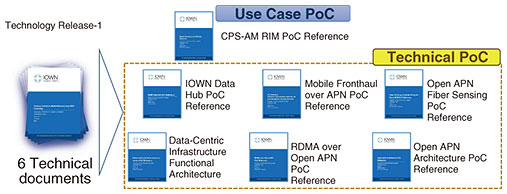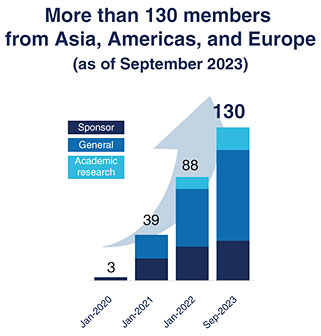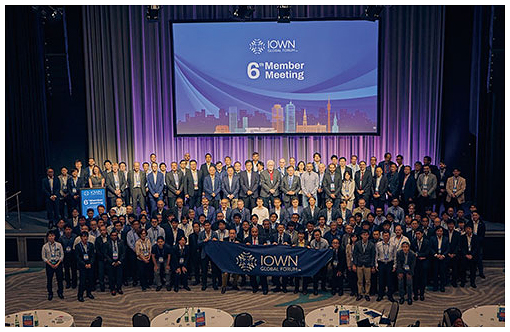 |
|||||||||||
|
|
|||||||||||
|
Feature Articles: Recent Developments in the IOWN Global Forum Vol. 22, No. 2, pp. 11–18, Feb. 2024. https://doi.org/10.53829/ntr202402fa1 Latest Activities in the IOWN Global ForumAbstractWith a view to creating a smart world, the concept of the Innovative Optical and Wireless Network (IOWN) aims to create a next-generation communication and computing infrastructure that features ultra-high capacity, ultra-low latency, and ultra-low power consumption. With input from global member companies, the IOWN Global Forum has been developing technical architectures and use cases and conducting proof of concept (PoC) activities and implementation verification. This article introduces the latest activities of the IOWN Global Forum, as well as the PoC Reference documents and reference-implementation-model documents that reflect the results of these efforts. Keywords: IOWN, Global Forum, optical network 1. IOWN concept and the IOWN Global ForumIn May 2019, with a view to creating a sustainable and prosperous smart world, NTT proposed the concept of the Innovative Optical and Wireless Network (IOWN), which will break through current limitations and build a communication and computing infrastructure that features ultra-high capacity, ultra-low latency, and ultra-low power consumption. NTT is conducting research and development with the goals of increasing power efficiency by a factor of 100, transmission capacity by a factor of 125, and end-to-end low latency performance by a factor of 200 by the year 2030. Achieving these goals will call for a major transformation in information processing, communication, and network infrastructure, which in turn will require the development and combination of many innovative technologies. Such endeavors cannot be achieved by the NTT Group alone. Thus, in January 2020, Intel Corporation, Sony Corporation, and NTT Corporation established the IOWN Global Forum, an international non-profit organization dedicated to the future of communications. During the four years since then, the forum has been developing the innovative technical frameworks, technical specifications, and reference architectures needed to achieve the above goals and pressed forward to actualize a new communication and computing infrastructure, IOWN. Figure 1 shows the overall technical structure of IOWN [1]. What is immediately apparent is that its network, the Open All-Photonic Network (Open APN), enables communication with deterministic transmission rates and latency. Placed on top of that is an architecture called a data-centric infrastructure (DCI), which achieves efficient data transfer and processing using accelerators. Via the APN, two remotely located DCIs can transfer data at high speed and with low latency and combine multiple distributed datacenters to form one large virtual datacenter. The IOWN Global Forum is developing the IOWN Data Hub (IDH) to enable scalable and highly available database storage that is based on the distributed database architecture within a cluster by using the above capabilities of the DCI. The forum will implement various use cases on top of the IDH and enable Digital Twin Computing by linking digital twins that digitally represent various objects in the real world. It will feed the results of Digital Twin Computing back to the real world to create a smart world.
The activities of the IOWN Global Forum are characterized by the fact that it studies not only technology but also use cases so that the desired smart world can be envisioned in concrete terms from the beginning. Two working groups (WGs) have been established for this purpose: the Use Case WG and Technology WG (Fig. 2). The Use Case WG develops the details of applications in line with the vision of a smart world, estimates IOWN’s potential impact on business, and discusses technical requirements, while the Technology WG discusses technical solutions, such as reference architectures, protocols, interfaces, and other specifications. The two WGs work in close collaboration with each other (Fig. 3).
The IOWN Global Forum has developed and followed a roadmap consisting of phases, each of which spanning about eighteen months. In Phase 1 (up to January 2022), entitled “Direction and Plan Definition,” the forum formulated a vision, developed major use cases, established a basic technical framework, and identified the issues that need to be considered. In Phase 2 (up to July 2023), entitled “Acceleration toward Vision 2030/Use Case Realization,” the forum updated the vision, use cases, and architecture and developed technical specifications and reference implementation models (RIMs), and conducted proof of concept (PoC) activities. Currently, in Phase 3, entitled “Preparation of Real-World Deployment and Business Impact,” the IOWN Global Forum is accelerating its efforts toward the actualization of IOWN (Fig. 4).
As a way of presenting the main initiatives of the IOWN Global Forum, this article introduces the results of Phase 2, the forum’s organization, the status of its activities, and its planned activities for the future. 2. Phase 2 activities and key results2.1 PoC ReferencesIn Phase 1, the IOWN Global Forum studied the architectures of the Open APN, DCI, IDH, and other technical elements of IOWN, and released six technical documents in January 2022. The main activities in Phase 2 were to study implementation details and conduct PoC activities on the basis of the architectures developed in Phase 1. To advance PoC activities and promote market deployment and collaboration among the parties concerned beyond simple technical demonstration, the IOWN Global Forum compiled PoC Reference documents, which summarize reference use cases, the features that key technologies must deliver, and evaluation metrics for each technical theme. By November 2022, the forum had released the following seven documents (Fig. 5): (1) Open APN Architecture PoC Reference (2) RDMA over Open APN PoC Reference (3) Data-centric-infrastructure-as-a-service PoC Reference (4) Mobile Fronthaul over APN PoC Reference (5) IOWN Data Hub PoC Reference (6) Fiber Sensing Crosstalk Study for Open APN PoC Reference (7) PoC Reference: Reference Implementation Model for the Area Management Security Use Case
The main PoC Reference documents that will be discussed in the Feature Articles in this issue are introduced below. The Open APN Architecture is an open architecture for building the multi-vendor APN that enables communications with deterministic transmission rates and latency. PoC Reference (1) describes dynamic optical path design, open interfaces, and support for multi-vendor environments. PoC Reference (4) describes applying the Open APN to mobile fronthaul and presents interface requirements, dynamic path switching, etc. to enable mobile network operators to use the Open APN. The IDH is an architecture for database storage that is hierarchically distributed to meet stringent requirements. PoC Reference (5) presents smart factory, smart grid, and metaverse scenarios in which the IDH is applied and describes the configuration and evaluation of the implementation. A DCI is an architecture for streamlining data transfer by incorporating network interfaces into data-processing modules, such as accelerators. This enables multiple remotely located DCIs to share information technology (IT) resources by transferring data at high speed and with low latency via the APN. PoC Reference (3) shows use cases, such as area management, virtualized radio access networks, and disaggregated IDH, and describes the implementation and evaluation of the PoC. 2.2 RIMsThe IOWN Global Forum has developed RIMs for promising use cases. It is important to develop full-stack engineering of these models by taking the characteristics of each use case into consideration. RIMs provide best practices for overall implementation. The following RIM documents have been released: (1) RIM for the Interactive Live Music Entertainment Use Case (2) RIM for the Area Management Security Use Case (3) RIM for the Remote-Controlled Robotic Inspection Use Case Interactive Live Music Entertainment is a use case selected as an AI-Integrated Communication. This use case delivers the musical performances of artists with volumetric video and audio to the audience in real time and reflects the audience’s reactions in the virtual space. RIM document (1) provides the technical specifications of the devices used in the use case and functional requirements of the system and presents guidelines for the implementation of the overall configuration. Area Management Security is a use case selected as a cyber-physical system. In this use case, a large number of surveillance cameras are installed in urban areas and facilities to prevent crime and ensure security. The Open APN, DCI, and IDH are applied to this use case. RIM document (2) shows an analysis of the data flows and workload of camera-captured videos and other data in an implementation configuration and describes the configuration and effects of each technology when it is applied. Remote-Controlled Robotic Inspection is a use case for the remote control of a factory, as used by petrochemical plants in their production processes. RIM document (3) presents the requirements to be met by the data to be acquired, remote-control requirements, an analysis of data flows, and the implementation configuration and its effects. As described above, the IOWN Global Forum has been analyzing the requirements, studying the effects of the PoC-implementation models for specific use cases on the basis of the PoC Reference documents for each IOWN component technology, releasing the results of these studies, and conducting actual PoC verification projects on the basis of these results. The reports on the results of these PoC verification projects will be released in the coming years. 3. Organization and activities of the IOWN Global Forum3.1 Expansion of membershipThe IOWN Global Forum was established in January 2020 by three companies (Intel, Sony, and NTT). The number of members has since been rapidly increasing, reaching 39 organizations by January 2021, 88 by January 2022, and exceeding 130 by September 2023. New members are joining almost every month (Fig. 6).
Reflecting the characteristics of the forum’s activities wherein use-case studies and technical studies proceed hand in hand, not only those who study and develop IOWN Global Forum technologies but also many of those who use these technologies participate in the forum. Participation in the IOWN Global Forum is not confined to enterprises. Research institutes, universities, and academic institutions are also actively involved. Municipalities are also taking part, and major cities around the world have expressed their interest [2]. 3.2 Recent activities of the IOWN Global ForumSince its inception, due to the COVID-19 pandemic, the IOWN Global Forum has conducted its activities online. However, as the pandemic has now subsided globally and there has been a revival of social activities from the latter half of 2022, the forum has gradually shifted to holding a hybrid of online and offline meetings. In October 2022, the 5th Member Meeting—the first locally held member meeting—took place in New York City in a hybrid format, with 136 local participants and more than 300 online participants from 44 member organizations located in various countries. In April 2023, after the peak of the 8th coronavirus wave in Japan, the 3rd Annual Member Meeting—the first locally held annual member meeting—was held in Osaka in a hybrid format. More than 400 participants from 78 member organizations from different countries gathered in Osaka while many others participated online. There was lively discussion around updating the forum’s vision and use cases, and the related technologies were intensively considered. In September 2023, the 6th Member Meeting was held in Munich [3]. This was the first member meeting held in Europe and was attended by more than 400 people (190 locally) from 89 member organizations from various countries (Fig. 7). All meetings were operated in a hybrid format, which allowed many people to participate in meetings online while enabling local participants to hold in-depth discussions. Prior to the meeting, a call for proposals regarding activities in Phase 3 was issued, and 34 proposals were received. In the Munich meeting, breakout workshops, each dedicated to a specific subject category, were organized and active technical discussions on these proposals took place. The meeting also officially released a reference document that identified key values and presented a roadmap for technological evolution [4]. The values identified included the importance of a holistic approach, an implementation-driven approach, and system-level solutions. A roadmap for evolution in networking and computing was presented. “An Implementation of Heterogeneous and Disaggregated Computing for DCI as a Service” was also approved as the first recognized PoC report. More PoC reports will be published in the coming years to demonstrate the value and performance of IOWN technologies.
3.3 Other activitiesIn parallel with the Use Case and Technology WGs, the Liaison WG of the IOWN Global Forum has been active, promoting collaboration with other technical and standardization organizations [5]. The Liaison WG exchanges various types of information with collaborating organizations, jointly studies specifications, and seeks to have the IOWN Global Forum’s technologies adopted as standards. The Liaison WG is currently collaborating with the International Telecommunication Union (ITU) Radiocommunication Sector, the ITU Telecommunication Standardization Sector, the Linux Foundation, OpenROADM, and other organizations, and plans to expand the scope of collaborating organizations. The IOWN Global Forum is also actively engaged in external activities as part of its marketing initiative. In addition to giving lectures and demonstrations at events held by member companies, the forum participates in events hosted by the information and communication industry and academic conferences, giving speeches and organizing exhibitions. In 2023, the IOWN Global Forum jointly set up an exhibit with other companies at the Mobile World Congress (MWC) held in Barcelona in February, gave a speech at the Optical Fiber Communication Conference and Exposition (OFC) held in San Diego in March and at the Institute of Electrical and Electronics Engineers (IEEE) International Conference on Communications held in Rome in June. At the NTT booth at Interop Tokyo 2023 held in Chiba, Japan in June, NTT exhibited the remote control of a robot and a virtual-reality table-tennis application using remote graphics processing units to demonstrate the ultra-low latency achieved using the Open APN. 4. Activities and prospects for Phase 3In Phase 3, entitled “Preparation of Real-World Deployment and Business Impact,” the IOWN Global Forum aims to further develop technology, expand the organization and activities, and create business cases toward the deployment of IOWN. The forum will also conduct PoC and technical evaluation of specific use cases and release PoC-result reports. It will develop technical-specification documents, deepen collaboration with other organizations, and work toward standardization of the forum’s specifications. It will also seek to deploy IOWN by expanding support for the forum members, such as holding local events and seminars, to accelerate studies tailored to each country or region so that many user companies can use IOWN in their respective businesses. References
|
|||||||||||

















